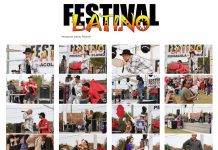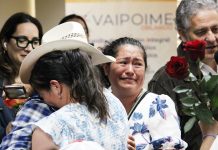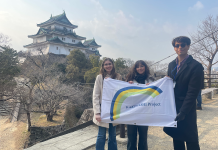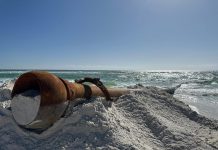COVID-19 Avanza en la Comunidad Latina de la Costa del Golfo
Por Heidi Travis
Estados Unidos se ha convertido rápidamente en el epicentro de COVID-19. Con más de 3 millones de casos, el virus ha afectado a todos en alguna manera.
Los grupos minoritarios se ven desproporcionadamente afectados. Según los Centros para el Control de Enfermedades (CDC), los latinos tienen una tasa de infección cuatro veces más alta que los no latinos debido a las “inequidades sistémicas y sociales de larga data [que] han puesto a algunos miembros de grupos de minorías raciales y étnicas de mayor riesgo de contraer Covid-19 o experimenta una enfermedad grave independientemente de la edad “.
La crisis está afectando a la comunidad latina de la Costa del Golfo. Hablamos con algunos latinos que se recuperaban de COVID-19. Desean permanecer en el anonimato pero quieren compartir sus historias. Los llamaremos Sondra, Clara y Roberto:
Se suponía que era una ocasión alegre, una reunión con 16 amigos en un restaurante en el centro de Pensacola para celebrar el cumpleaños de Sondra. Ella reservó una habitación privada para limitar su exposición. Esa noche celebraron, dos días después aparecieron los síntomas.
“Fuimos al restaurante el 19 de junio. El 21 empecé a toser, pero como soy paciente de asma, lo estaba tratando como si fuera asma. Acabo de usar mi tratamiento de respiración. No tuve fiebre. No tenía nada más,” dijo Sondra. “¡Pero entonces mi esposo desarrolló fiebre, sarpullido y le dolia todo el cuerpo!”
Sondra y su esposo se hicieron el examen y, dos días después, los resultados fueron positivos para COVID-19.
En este punto, Sondra y su esposo tenían miedo, en particular por su esposo, quien dijo que Sondra desarrolló todos los síntomas que puedas imaginar.
En los días siguientes, las 16 personas que asistieron a su cena de cumpleaños presentaron positivo para COVID-19.
“Tenía una amiga que estaba con nosotros en mi cumpleaños y su esposo tuvo que llevarla al hospital porque no podía respirar.” Pero la persona que estaba sentada junto a ella, solo tenía un dolor en la cadera. Ella no ha desarrollado ningún otro síntoma. Otra persona tuvo dolor de cabeza. Otra persona desarrolló la erupción evidente en todo su cuerpo,” dijo Sondra. “Entonces, lo que estamos viendo es que todos obtuvimos resultados positivos, pero nadie tiene exactamente los mismos síntomas. No sabemos cómo se mostrará este virus,” dijo.
De las 16 personas que asistieron a su fiesta de cumpleaños y tuvieron resultados positivo, seis nunca desarrollaron síntomas y han permanecido asintomáticos.
Profundizando en el misterio de COVID-19 está Clara, una maestra de español en Mobile que recientemente tuvo resultado positivo de COVID-19. Clara se había quedado en casa desde que cerraron las escuelas en marzo. Evitó las reuniones con amigos, rechazó las oportunidades de tutoría. Cuando tenía que salir, siempre llevaba una máscara y mantenía la distancia.
“Tengo alergias estacionales, así que trato de tener cuidado con eso si salgo,” dijo Clara. “Siempre trato de mantener mi carreta de compras limpia y desinfectada, llevando mis propias toallitas desinfectantes.”
Desde que comenzó la cuarentena, Clara se ha preocupado especialmente por comer bien y hacer mucho ejercicio, con la esperanza de mantenerse lo más saludable posible y evitar enfermedades.
“Cuando tuve la fiebre, pude sentir que me ardían las mejillas. Cuando pude sentir que la temperatura de mi cuerpo no era normal, comencé a sentir pánico. Realmente comencé a entrar en pánico porque escuchas mucho en las noticias sobre cómo las personas se enferman seriamente y solo recé para que ese no fuera el caso para mí,” dijo Clara.
“Sin embargo, a medida que pasaron los días, me he calmado mucho. Tengo mucha fe en que no empeorará más de lo que estoy sintiendo en este momento. Creo que soy muy afortunada porque no experimenté toda la gama de síntomas porque no tengo ninguna condición subyacente,” dijo.
La forma en que Clara contrajo COVID-19 sigue siendo un misterio, aunque sospecha que debe haber sido cuando fue de compras.
Si bien tanto Sondra como Clara se han recuperado bien, les quedan muchas preguntas y preocupaciones. Como profesora de español, Clara sirve de enlace entre las familias inmigrantes y el distrito escolar. Le preocupa que sus experiencias con COVID-19 sean muy diferentes a las de ella.
“Creo que muchas de las familias se verán afectadas de manera desproporcionada. Los de los grupos minoritarios, hogares monoparentales, los indocumentados, los que no tienen una red de apoyo, estarán en gran desventaja,” dijo Clara.
Sondra se hace eco de muchos de los sentimientos de Clara y agrega que las personas en nuestra comunidad deben tener cuidado de tomar esto en serio y cuidarse a sí mismos.
“Hispanos, no somos inmunes,” dijo Sondra. “Esto es algo que puede tocar a cualquiera”.
Y golpea a algunos más fuerte que a otros.
Roberto, un militar retirado de la Fuerza Aérea, finalmente se está recuperando en su casa después de cuatro días y medio en el hospital.
“Comenzó el 1 de julio cuando comencé a sentir un poco de congestión nasal, luego, de noche, se desató el infierno. Tenía fiebre alta Fiebres de 104, 105,” dijo Roberto.
“Tenía escalofríos que eran muy difíciles de controlar. Entonces, después de estar dos días así, finalmente pude levantarme e ir al médico.”
Dio positivo por COVID-19 y fue ingresado en el hospital donde permaneció durante cuatro días y medio para recibir tratamiento para sus fiebres.
“Mis brazos se ven negros con todo tipo de marcas que desde allí intentaban poner en los IV,” dijo Roberto. “Fue difícil.”
Roberto también perdió su sentido de sabor y el olfato, lo que le ha dificultado comer y recuperar fuerzas. Roberto dice que fue tratado con antibióticos y un medicamento autorizado para uso de emergencia. Continúa en cuarentena en casa, separado del resto de su familia y sigue las órdenes de su médico de mantenerse hidratado, descansar y caminar cuando pueda.
“Me siento mejor hasta cierto punto, pero la pelea no está cerca del final,” dijo Roberto. “Solo trato de tomarlo un día a la vez. No puedo ir mucho más allá de eso. Al menos me siento bien de estar en casa.”
Roberto compartió estas palabras de advertencia: “[COVID-19] es real. Es muy peligroso. Mire lo que hace e intente mantenerse a salvo de esto porque es realmente malo. Nunca le deseo esto a nadie.”
COVID-19 Moves Through Gulf Coast Latino Community
By Heidi Travis
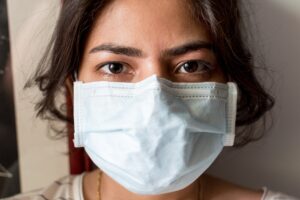 The United States has quickly become the epicenter of COVID-19. With more than 3 million cases, the virus has affected everyone in some way.
The United States has quickly become the epicenter of COVID-19. With more than 3 million cases, the virus has affected everyone in some way.
Minority groups are disproportionately affected. According to the Centers for Disease Control (CDC), Latinos have an infection rate four times higher than non-Latinos due to “long-standing systemic and social inequities [that] have put some members of racial and ethnic minorities groups at increased risk of getting Covid-19 or experiencing severe illness regardless of age.”
The crisis is rippling into the Gulf Coast Latino community. We spoke with a few Latinos recovering from COVID-19. They wish to remain anonymous but want to share their stories. We will call them Sondra, Clara and Roberto.
It was supposed to be a joyous occasion, a get together with 16 friends at a restaurant in downtown Pensacola to celebrate Sondra’s birthday. She reserved a private room to limit their exposure. That night they celebrated, two days later the symptoms appeared.
“We went to the restaurant on June 19th. On the 21st I started coughing but because I am an asthma patient, I was treating it like it was asthma. I just used my breathing treatment. I didn’t have a fever. I didn’t have anything else,” said Sondra. “But then my husband developed a fever, a rash, and he was hurting all over!”
Sondra and her husband got tested and two days later the results came back positive for COVID-19.
At this point, Sondra and her husband were afraid, in particular for her husband who Sondra said developed every symptom that you can imagine.
In the following days, all 16 people who attended her birthday dinner tested positive for COVID-19.
“I had a friend who was with us on my birthday and her husband had to take her to the hospital because she couldn’t’ breathe. But then the person who was sitting by her only had a pain in her hip. She hasn’t developed any other symptoms. Another person had a headache. Another person developed the obvious rash all over his whole body,” said Sondra.
“So, what we are seeing is that we all tested positive, but no one has exactly the same symptoms. We don’t know how this virus will show,” she said.
Of the 16 people who attended her birthday party and tested positive, six never developed symptoms and have remained asymptomatic.
Deepening the mystery of COVID-19 is Clara, a Spanish teacher in Mobile who recently tested positive for COVID-19. Clara had been staying home since schools closed in March. She avoided get-togethers with friends, turned down tutoring opportunities. When she absolutely had to go out, she always wore a mask and kept her distance.
“I have seasonal allergies so I kind of try to be careful with that if I go out,” said Clara. “I always try to keep my shopping cart clean and disinfected, carrying my own little disinfectant wipes.”
Since quarantine began, Clara has been taking particular care to eat well and get plenty of exercise, hoping to stay as healthy as possible and avoid sickness.
“When I got the fever, I could feel my cheeks burning. When I could feel my body temperature was just not normal, I started to panic. I really started to panic because you hear a lot in the news about how people get extremely sick and I just prayed that that wasn’t going to be the case for me,” said Clara.
“However, as the days have gone by, I have calmed myself down a lot. I have a lot of faith that it will not get any worse than what I’m feeling right now. I guess I’m kind of a lucky one that I didn’t experience the whole array of symptoms because I don’t have any underlying conditions,” she said.
How Clara came down with COVID-19 remains a mystery, though she suspects it must have been when she went grocery shopping.
While both Sondra and Clara have been recovering well, they are left with many questions and concerns.
As a Spanish teacher, Clara serves as a liaison between immigrant families and the school district. She worries that their experiences with COVID-19 will be very different from hers.
“I think a lot of the families are going to be disproportionately affected. Those from the minority groups, single-parent homes, those who are undocumented—those who don’t have a network of support—will be at a great disadvantage,” said Clara.
Sondra echoes many of Clara’s sentiments and adds that people in our community should be careful to take this seriously and take care of themselves.
“Hispanics, we are not immune,” said Sondra. “This is something that can touch anyone.”
And it hits some harder than others.
Roberto, a retired Air Force serviceman, is finally recovering at home after a harrowing four and a half days at the hospital.
“It started July 1st when I started to feel a little sinus congestion, then at nighttime, all hell broke loose. I had high fevers. Fevers of 104, 105,” said Roberto.
“I had chills that were very hard to control. So, after being two days like that I was finally able to stand up and go to the doctor.”
He tested positive for COVID-19 and was admitted to the hospital where he stayed for four and a half days to receive treatment for his fevers.
“My arms look black with all sorts of markings from there they kept trying to put in the IVs,” Roberto said. “It was tough.”
Roberto also lost his sense of taste and smell, which has made it harder for him to eat and regain his strength.
Roberto says that he was treated with antibiotics and a drug that was authorized for emergency use. He continues to quarantine at home, separate from the rest of his family and follows his doctor’s orders to stay hydrated, rest up and to walk when he can.
“I feel better to a certain degree, but the fight is nowhere near the end,” Roberto said. “I just try to take it one day at a time. I cannot go too far beyond that. I at least feel good that I am at home.”
Roberto shared these words of warning: “[COVID-19] is real. It’s very dangerous. Watch what you do and try to stay safe from this because it’s really bad. I don’t ever wish this on anybody.”





